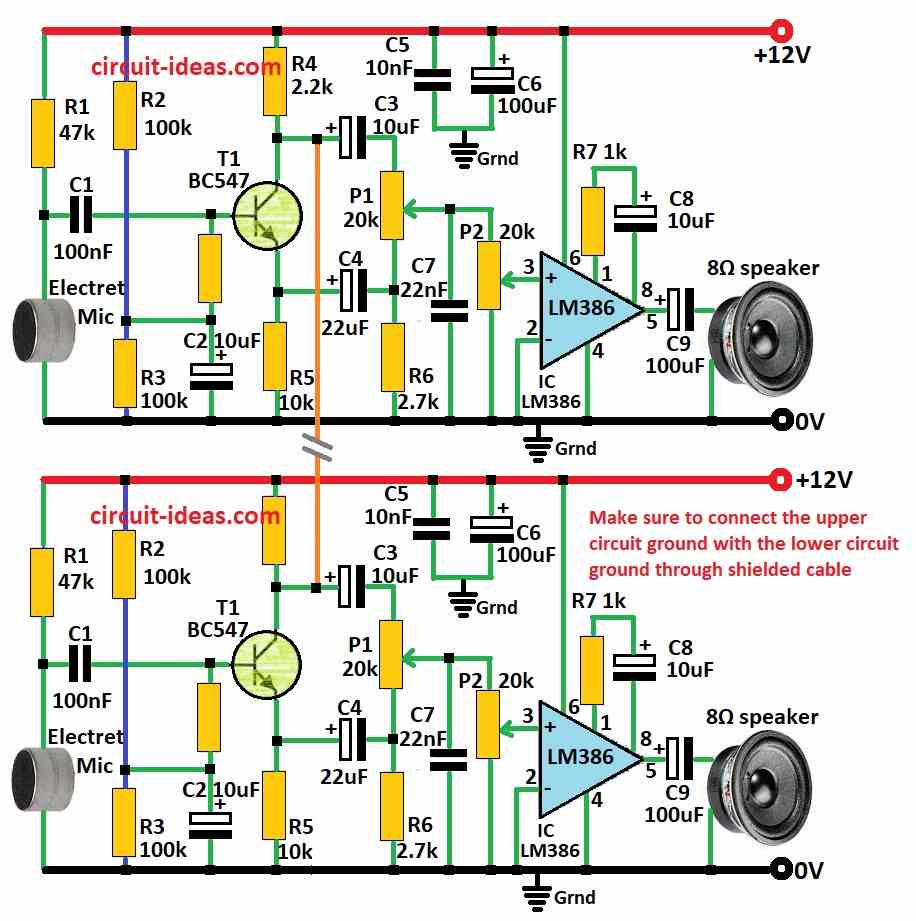This intercom circuit is like a fancy walkie talkie for inside a household of a building .
Instead of buttons it uses electronics to let you talk hands free.
You speak into a microphone, which changes your voice into electrical signals.
These signals are made stronger by an amplifier circuit.
A clever part of the circuit cancels out the sound from your own speaker preventing an echo or howling noise.
But the same signal gets sent to the other intercom unit, where it is amplified again and played through their speaker so you can hear each other clearly.
Knobs allow you to adjust the volume and minimize any leftover sound from your own speaker.
Circuit Working:

Parts List:
| Component Type | Value | Quantity |
|---|---|---|
| Resistors (All resistors are 1/4 watt unless specified) | 47k | 2 |
| 2.2k | 2 | |
| 10k | 2 | |
| 2.7k | 2 | |
| 1k | 2 | |
| 100k | 4 | |
| Potentiometer 20k | 4 | |
| Capacitors | Ceramic 100nF | 2 |
| Ceramic 10nF | 2 | |
| Ceramic 22nF | 2 | |
| Electrolytic 10μF | 6 | |
| Electrolytic 22μF | 2 | |
| Electrolytic 100μF | 4 | |
| Semiconductors | IC LM386 | 2 |
| Transistors BC547 | 2 | |
| Other Components | Electret Mic | 2 |
| 8Ω Speaker | 2 |
Below are the process of circuit working and how to build steps:
This intercom circuit utilizes a single transistor for microphone amplification and an LM386 IC for overall audio power amplification.
It facilitates hands free communication by keeping both microphones and speakers constantly active.
To eliminate acoustic feedback larsen effect, the microphone pre amplifier transistor introduces a 180 degree phase shift.
The audio signal is then tapped at both the collector shifted and emitter in phase outputs.
These outputs are subsequently mixed using capacitors 10uF and 22uF a resistor 2.7k and a potentiometer 20k.
This mixing stage effectively cancels out a significant portion of the original signal resulting in minimal speaker output from the same unit reduced self interference.
However, since the collectors of both intercom units are interconnected, the phase shifted signal from one unit seamlessly reaches the audio amplifier of the other unit without attenuation.
This ensures clear and loud audio reproduction on the receiving ends speaker.
The operation is reciprocal meaning speaking into either microphone transmits the phase shifted signal for clear reception on the other unit.
By adjusting the 20k potentiometer, the user can achieve minimal residual speaker output at their own unit while guaranteeing loud and intelligible audio reception from the other unit.
The second 20k potentiometer serves as a standard volume control.
Formulas:
The LM386 integrated circuit, which is frequently used for audio amplification, has the following important formulas:
Gain (Voltage):
The external components attached to the LM386 integrated circuit IC specifically, the values of the capacitor and resistor between its pins determine the ICs various gain levels.
The following formula may be used to get the gain (voltage):
Gv = 20 × Rf / Rin
where,
- Vg stands for voltage gain.
- The resistor that connects pins 1 and 8 of the LM386 is called Rf, and it regulates gain.
- The input resistance linked to pin 3 of the LM386 is represented by Rin.
Power Gain (Power Amplification):
The LM386 ICs power gain, which establishes the maximum power at which the signal may be amplified, is roughly equivalent to the voltage gain squared:
Gp = Gv2
This is an estimate of the audio signal strength amplified by the LM386.
Comprehending the gain formulae of the LM386 integrated circuit and the transistors amplification properties is essential for both developing and comprehending these circuits.
The total functionality and properties of the intercom circuit will depend on the precise values of the resistors, capacitors and other parts around these devices.
How to Build:
To build a Simple Intercom Circuit follow the below mentioned connections steps:
- Connect pin 1 of IC LM386 through a R7 resistor, connect pin 2 of IC LM386 to ground, connect pin 3 of IC LM386 to P2 pot, connect pin 4 of IC LM386 to ground, connect pin 5 of IC LM386 to one end of 8 ohm speaker through capacitor C9, connect pin 6 of IC LM386 to 12V positive supply, connect pin 8 of IC LM386 to one end of capacitor C8.
- Connect transistor T1 base to one end of capacitor C1, collector to positive supply through resistor R4, and emitter of transistor T1 to ground through resistor R5.
- Connect one end of electret Mic to positive supply through resistor R1 and other end to ground.
- Connect one end of 8 ohm speaker to pin 5 of IC LM386 and other end to ground.
- Connect one end of capacitor C5 to positive supply and other end to ground.
- Connect one end of capacitor C6 to positive supply and other end to ground.
- The orange connection line between the upper and the lower circuits must be a shielded cable.
- The grounds of upper and lower circuits must be also connected using a shielded cable
Safety Measures:
- Always double check the connections when experimenting the circuit.
- Take care when soldering components to prevent overheating or shorts.
- Before powering on, verify all connections are secure and follow the circuit diagram
Conclusion:
This intercom circuit offers a free hand communication solution with a clever design to prevent feedback.
By utilizing a single transistor for microphone pre amplification and an LM386 IC for overall power amplification, it achieves clear audio transmission while maintaining safety due to low voltage and current operation.
Leave a Reply